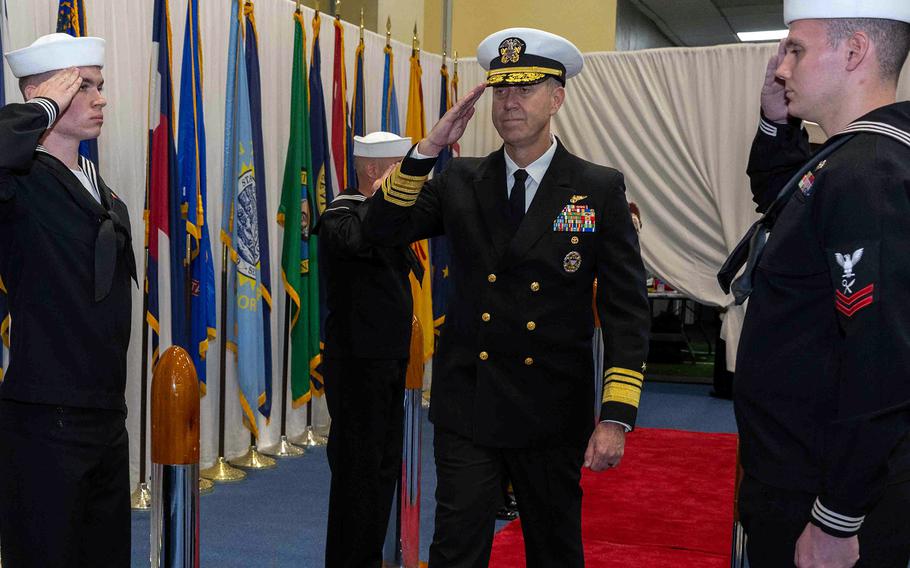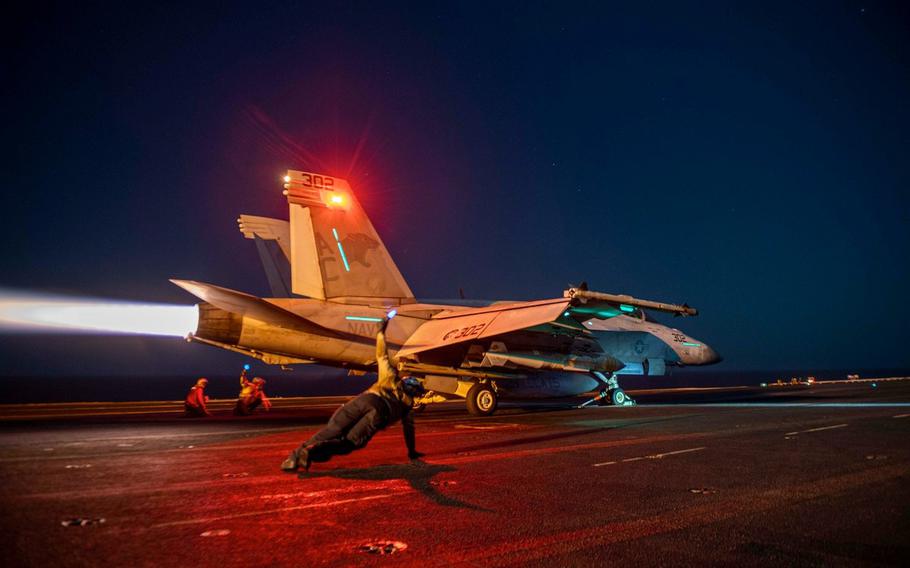
Vice Adm. George Wikoff, commander of U.S. Naval Forces Central Command and U.S. 5th Fleet, says a U.S.-led coalition is succeeding in defending commercial shipping against Iranian-backed Houthi militant attacks in the Red Sea. Wikoff, center, assumed command last month at Naval Support Activity Bahrain and since has been in regular communication with maritime industry leaders assuring them of U.S. commitment. (U.S. Navy)
NAPLES, Italy — A U.S. Navy-led coalition is succeeding at protecting commercial shipping in the Red Sea from militant attacks, while sailors work at a pace unseen in the Middle East in decades, the commander of the service’s forces in the region said.
American personnel “have been asked to perform at a tempo and at a level that our Navy has not operated in since at least the Tanker War of the ’80s,” Vice Adm. George Wikoff, commander of U.S. Naval Forces Central Command/U.S. 5th Fleet, said Thursday.
He was referring to a series of Iranian and Iraqi military attacks from about 1984 to 1988 on commercial shipping in the Persian Gulf. Nowadays, the attackers are Houthi militants in Yemen who are backed by Iran and say they are retaliating against Israel-linked ships, though many of the ships they’ve targeted have no apparent connection to Israel.
The Houthis on Monday also denied involvement in three severed Red Sea underwater cables that provide internet and telecommunications around the world.
Combined U.S. and coalition forces destroyed at least 26 missiles and 26 drones preparing to launch or already launched into the Red Sea from Feb. 23 through March 1, according to U.S. Central Command statements over the same period.
At the same time, Navy ships also have fended off direct attacks and protected other vessels, Wikoff said.

A U.S. Navy jet prepares for takeoff against Houthi targets in Yemen, Feb. 24, 2024. Vice Adm. George Wikoff, commander of U.S. Naval Forces Central Command/U.S. 5th Fleet says sailors are performing at a tempo and at a level that the Navy has not operated in since at least the Tanker War of the 1980s. (U.S. Naval Forces Central Command/X)
One of the latest of those actions was on Feb. 24, when the destroyer USS Mason shot down an anti-ship ballistic missile targeting a fuel tanker, according to CENTCOM.
U.S. and coalition strikes on Houthi military facilities in Yemen have destroyed or degraded more than 150 missiles and launchers since Jan. 11, a Pentagon spokesman said last week.
But despite those efforts, a handful of Houthi attacks have found their targets, notably a British-owned bulk carrier struck by a missile Feb. 18, which sank Saturday.
Still, about 4,700 ships have transited the waterway since Dec. 1. That’s about a 25% decline over the same period last year, when about 6,300 vessels moved through the waterway, according to figures from NAVCENT/U.S. 5th fleet.
Most normal merchant traffic is continuing to transit the Red Sea, an indication that the service’s defensive operations, specifically those through the U.S.-led Operation Prosperity Guardian, are working, Wikoff said.
“My reassurance is that shipping continues,” said Wikoff, who assumed command of the Navy’s forces in the Middle East last month. He also commands Combined Maritime Forces, a 41-nation maritime partnership focused on counterpiracy, counterterrorism and drug smuggling, among other operations.
Wikoff has been in regular contact with maritime industry leaders to reassure them of U.S. commitment to protecting shipping.
That resolve is echoed by the more than 20 nations involved in the operation and by the recent creation of a European Union-led mission also operating in the Red Sea, he said.
On Saturday, the Italian destroyer Duilio shot down a Houthi drone targeting it in the Red Sea, the Italian Defense Ministry said in a statement the same day. The drone was about 4 miles from the ship, according to the statement.
On Feb. 27, a German warship shot down two Houthi drones in separate attacks. Both countries are part of the EU Aspides mission.
Houthi militants say their attacks will continue until there is a cease-fire declared in Gaza.
“We continue to be committed to this mission,” said Wikoff, who praised U.S. sailors for their sacrifices and work in such a high-stakes environment. “We are preserving freedom of navigation, and we are focused on saving lives and livelihoods of people.”